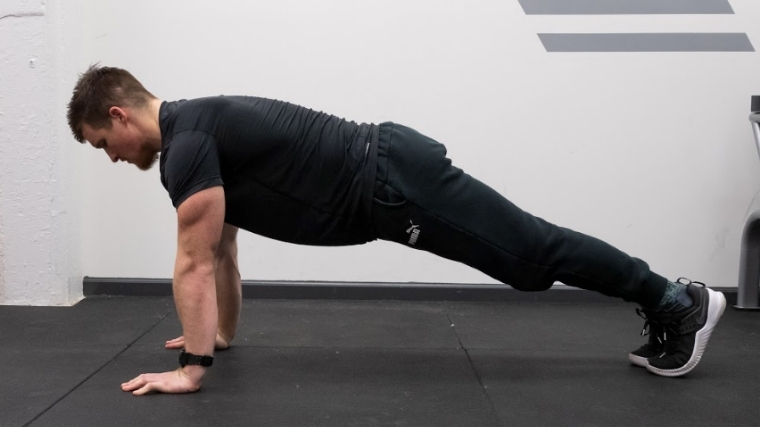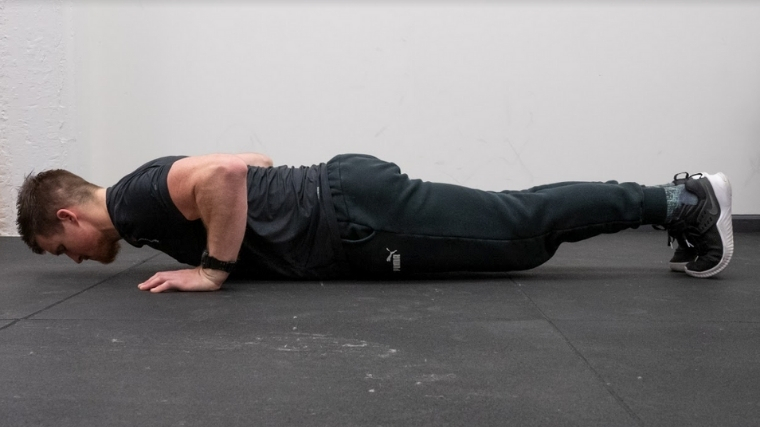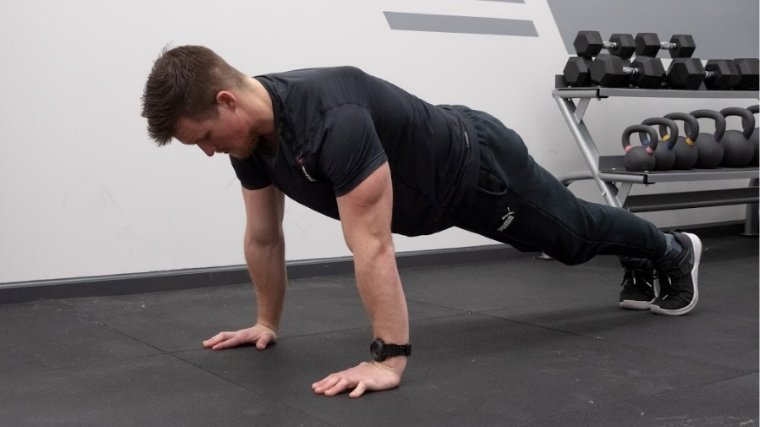The push-up is one of the first exercises most people ever perform. While commonly (and rightfully) considered a beginner’s exercise, there’s more to it than meets the eye. If you’ve been trying to pack muscle onto your chest, shoulders, and arms, or want to be a little more explosive, revisiting this calisthenics classic might be the right move.
Below is everything you’d want to know about the push-up — how to do it, variations, alternatives, programming recommendations, and answers to common questions you may have.
- How to Do the Push-Up
- Push-Up Sets and Reps
- Common Push-Up Mistakes
- Push-Up Variations
- Push-Up Alternatives
- Muscles Worked by the Push-Up
- Benefits of the Push-Up
- Who Should Do the Push-Up
- Frequently Asked Questions
How to Do the Push-Up
Even though most people have done push-ups at some point in their lives, it is still worth breaking down the exercise into its fundamental steps to ensure that it is being performed safely and effectively. After all, technique is critical when it comes to reaping the benefits of any exercise.
Step 1 — Brace & Set
Clear any stray objects or clutter from the exercise area before beginning, and ensure that the surface you’re using isn’t slippery or unstable. Contrary to popular belief, training on a wobbly or uneven surface may not benefit joint stability. (1)
Assume a rigid plank position with hands pressed flat against the floor. Double-check your posture to ensure that your joints are aligned, all the way from the neck to the ankles. The head should be neutral, looking towards the floor slightly ahead of the hands. Brace the core tightly and try to “squeeze” the floor with your hands.
Coach’s Tip: Set your shoulders directly over your wrists to increase force output and reduce the risk of injury.
Step 2 — Descend
Take a deep breath in and slowly lower your torso by bending at the elbows. The torso and legs should descend together without breaking rigidity through the midline. The scapula should retract slightly while remaining in a depressed position.
Coach’s Tip: Maintain strict control of your tempo all the way down, particularly as you get closer to the floor, and touch it lightly with your chest.
Step 3 — Explode
Once the torso gently touches the floor, forcefully “press the ground away” by reversing the initial movement. Keep the torso and legs rigid as they were during the setup, elbows directly over the wrists, and return to the starting position.
Coach’s Tip: Pay extra attention to trunk posture. Do not compromise a rigid, braced spine while trying to be explosive off the ground.
Push-Up Sets and Reps
The push-up has a place in just about every exercise routine. That said, figuring out where it can provide value can be challenging. It is always wise to know the “why” of any exercise in a program.
- As a Beginner: 2-3 sets of up to 10 reps, focusing on your technique.
- For Bodybuilding: 3-4 sets of 12-15 reps, modified as needed to ensure you’re reaching near muscular failure.
- As a Conditioning Tool: Multiple sets of 10-15 reps with very low rest to keep your heart rate up.
[Read More: How to Do 100 Push-Ups a Day]
Common Push-Up Mistakes
Straightforward and simplistic aren’t necessarily the same thing. While the push-up is certainly a beginner’s movement (at least in its default state), there are still a few technical points to be mindful of, no matter how experienced you are in the gym.
Sagging Your Lower Back
Poor trunk rigidity is among the most common technical faults for most gymgoers who perform the push-up. In order to brace properly and maintain sound technique, your torso and legs should form a straight line. Many beginners will inadvertently sag at the hips or unknowingly let their lower backs fall into an arched position.
This posture isn’t strictly harmful, but it doesn’t allow for an effective transfer of force, nor will it help you train your abs. To remedy a sagging spine, actively contract your core, squeeze your glutes, and you can even think about tucking your pelvis “in and under” slightly, to create a minor posterior tilt.
Upper Body Misalignment
The best way to transfer force across your body and get the tension where you want it to be is to maintain vertical alignment of your joints. This means that, when viewed from the side in the starting position, your shoulders sit directly atop your elbows, which sit directly atop your wrists.
Avoid having your palms planted too far in front (or behind) your body. While intentionally changing hand position can be a viable means of tuning the difficulty of the push-up, standard technique necessitates that you keep everything stacked up nicely.
Push-Up Variations
Although the standard push-up more than meets the bar when improving strength and building muscle, there are options for changing it up to keep your workouts fresh and fun.
Plate-Loaded Push-Up
A lack of meaningful progressive overload is one of the big drawbacks of bodyweight training. That said, the push-up is one of the staple movements that can be easily loaded with increased resistance.
Simply placing a standard weight plate on your lower back while setting up is an easy way to ensure that you keep making gains once your body weight becomes too easy.
Close-Grip Push-Up
The standard posture for regular push-up blasts the pecs, delts, and triceps. Which muscle group takes more of the load can be adjusted by changing hand or arm position. By moving your hands closer to your midline — or even inside shoulder width — you can add stress to the triceps specifically.
As you shift load away from the larger pecs and the smaller muscles of the arm and shoulder, the exercise becomes significantly more challenging.
Single-Arm Push-Up
Possibly the most advanced version of the movement, the single-arm push-up is a real challenge for even experienced gymgoers. By placing one hand behind your back and centering your contact hand on the floor, the stability and strength demands of the exercise go through the roof.
While not exactly an appropriate tool for gaining muscle due to its steep learning curve and balance requirement, the sheer difficulty of the single-arm push-up makes it a great goal to work towards.
Push-Up Alternatives
The benefits of the push-up are extensive, but the fact remains that bodyweight training isn’t everyone’s cup of tea. Some people want more of a challenge. Others prefer having a heavy barbell in hand. Luckily, some alternatives check a lot of the same beneficial boxes the push-up provides.
Close-Grip Bench Press
The close-grip bench press is the go-to alternative for anyone who prefers to do their work with a bar. Similar in most ways to a standard bench press, by adjusting grip inward to be in line with the shoulder in the starting position, you can very closely mimic the movement of a push-up, thus hitting all of the same muscles.
The close-grip bench press obviously requires more equipment, but the potential payoff lies in your ability to load the movement and, therefore, easily apply progressive overload.
Dip
The calisthenic cousin of the push-up, in terms of movement, is the standard dip exercise. Performed with either your bodyweight or loaded via chains/bands, the dip also tightly mirrors the movement of a push-up while also being a viable calisthenic exercise for anyone without barbells or dumbbells.
The trade-off here is that the dip places more stress on the shoulder joint and can be dangerous if not performed with acute attention to technique.
Muscles Worked by the Push-Up
No exercise is a catch-all for muscle growth, but the push-up comes pretty close from a movement perspective. A well-designed training plan incorporates different elements and exercises to keep things challenging, and you can’t go wrong with the push-up if your goal is adding size.
Chest
The pectoralis major (pecs) is located on the front of the torso and is responsible for many of the primary motions of the arm, including flexion and adduction.
Delts
The deltoid (shoulder) muscle comprises three heads: anterior, medial/lateral, and posterior. The push-up primarily works the anterior deltoid responsible for raising the arm in front of the body.
Triceps
This upper body muscle is located on the back of the arm and is mainly designed to extend or straighten the elbow. Depending on how you perform the push-up, the triceps can be considered the prime mover.
Core
Colloquially, the “core” refers to the abdominal muscles but actually involves the musculature of the pelvis, lower back, and ribcage. These structures all work synergistically to stabilize the spine while other body segments (the arms) move in space.

[Read More: The Best Upper Body Exercises and Workouts]
The push-up affords many of the benefits of the standard plank.
Benefits of the Push-Up
Like any other exercise, the benefits of the push-up are contingent on good technique and strong focus. When performed properly, the push-up can be a tool with multiple applications both in and out of the gym.
Upper Body Hypertrophy
When it comes to hypertrophy, the push-up can hang in the ring even against staple exercises like the bench press, especially for beginners. (2) There is a lot of engagement from the pecs, deltoids, and triceps, as all three muscle groups work synergistically to move the body in space.
Total Body Coordination & Stability
If you’re new to exercise, you may find yourself having trouble stabilizing your body under stress. The push-up is especially good at developing body coordination as it reinforces a rigid torso while the limbs move in a controlled manner.
Strength Development
While not as effective as a bench press or weighted dip, the push-up can still develop upper body strength in beginner and intermediate athletes. Pure bodyweight push-ups will be plenty challenging for beginners, while advanced lifters will eventually need to add weight.
Convenience
If you don’t have access to a barbell or some dumbbells, the push-up is second to none for building strong pecs. Since this exercise requires no equipment and takes up limited space, it can be performed anywhere. This makes the push-up tremendously useful if you’re trying to stay in shape while traveling or are strapped for time.
Who Should Do the Push-Up
An exercise as fundamental and versatile as the push-up has a wide variety of applications. Recreational fitness enthusiasts and competitive athletes alike can reap the benefits of the exercise by customizing their technique or loading parameters.
[Related: How Tempo Training Can Progress Your Workouts]
Beginners
The push-up is an amazing beginner exercise due to its simplicity built on as the trainee becomes more comfortable or wants more of a challenge. The basic push-up is straightforward and perfectly suited for anyone just getting started with an exercise routine.
Bodybuilders
Most bodybuilding or hypertrophy programs include a litany of different movements to torch the pecs, and some even eschew the push-up altogether. However, an oft-overlooked benefit of the push-up is its application as a “burnout” exercise at the end of a workout.

[Read More: The Best Bodyweight Exercises, + Workouts and Tips From a CPT]
Those looking to pack on as much muscle as possible should consider adding a few sets of high-rep push-ups before they leave the gym to fatigue their chest, shoulders, and triceps fully.
Strength Athletes
Strength athletes aren’t generally focused on maximizing the growth of their chest and arms, but they should still make sure to train those muscles to maintain a balanced physique.
The push-up is a great plug-and-play auxiliary exercise for strength athletes because it allows them to stimulate muscles they don’t generally hit in their programming without accumulating so much fatigue that it interferes with their primary workout.
Elevate Your Workouts
You may be a few years into your gym career and think that the simple and unassuming push-up is in some way beneath you. While it is true that the longer you’re in the gym the more intricate your training will become, you shouldn’t think less of the basics. In fact, the opposite might be true.
[Read More: The Best Ab Exercises & Workouts, According to a CPT]
The push-up is a staple across all types of exercise for a reason — it does what you want it to do. No muss, no fuss. You can customize it to be as easy (or as hard) as you want, or leave it as-is and utilize push-ups as a way of giving your pecs a nice pump on your next chest day. Whatever you need it for, the push-up is there for you.
FAQs
Are push-ups safe for beginners?
Yes. As long as you do it correctly. The push-up is considered a cornerstone exercise for anyone new to an exercise regimen. The straightforward, low-impact technique makes it a safe, low-coordination exercise that targets multiple muscles at once. It is also highly scalable in terms of relative difficulty.
Can I perform push-ups every day?
In theory, yes, if you account for the total workload. An often-overlooked benefit of bodyweight training is its low fatigue factor — lack of high external resistance means the brain and body can handle a high volume of training and recover quickly, even daily.
What muscles do push ups work?
Push ups work a variety of muscles. The prime movers involved in the push up are the pec major, anterior (front) deltoid, and triceps. There are other muscles worked as well that serve as synergists, stabilizers, and antagonists.
How often can I do push ups?
Push ups can be performed relatively regularly as long as you have the energy and capabilities to do so. Since they’re a lower impact bodyweight movement, they’re slightly less taxing on the body as a whole. Program and use them based on your needs and capabilities.
What’s the best way to progress my push-ups?
While calisthenic training can hit the ceiling fairly quickly for experienced athletes, there are still ways to modify movements like the push-up so that they keep returning value. If a standard bodyweight push-up is too easy, adding a small weight plate on your lower back can bump the difficulty.
Alternatively, implementing “clapping” push-ups requires significantly more explosive power to perform successfully. Finally, a single-arm or even handstand push-up takes the exercise to the extreme end of difficulty without requiring external load.
References
1. Lehman G., Gilas D., Patel U. (2008) An unstable support surface does not increase scapulothoracic stabilizing muscle activity during push up and push up plus exercises. Manual Therapy 13(6), 500-506.
2. Kikuchi N., Nakazato K. (2017) Low-load bench press and push-up induce similar muscle hypertrophy and strength gain. Journal of Exercise Science & Fitness 15(1), 37-42.


